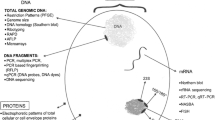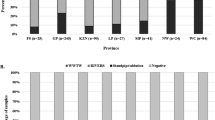Abstract
Transportation of Cryptosporidium oocysts in river type source water is of great concern in an area where extensive human activities exist. In this study, a total of 47 samples were collected from Tongxiang, China, where drinking source water was taken from a complicated river network system, by three sampling campaigns over a rainy season in 2009, to reveal the presence, genotypes, and likely source of Cryptosporidium oocysts in river water. Immunofluorescence microscopy analyses show that 37 (78.7%) were Cryptosporidium positive, with a mean concentration of 0.51 oocysts per liter. These results suggest that the protozoa were commonly distributed in the river network type source water of Tongxiang with a relatively low concentration level. PCR analysis was used to determine the species/genotypes of Cryptosporidium, which revealed the presence of the animal related species/genotypes including Cryptosporidium suis, Cryptosporidium fragile, and the avian III, pig II, cervine genotypes. Three of them were also detected in wastewater samples taken from neighboring animal farms, showing that farm animals rather than human might be the major pollution sources. This is the first report on simultaneous detection and genotyping of Cryptosporidium oocysts from surface water in China.


Similar content being viewed by others
References
Aldom JE, Chagla AH (1995) Recovery of Cryptosporidium oocysts from water by a membrane filter dissolution method. Lett Appl Microbiol 20:186–187
Cai J, Ye J, Du HL, Hu XW, Liu J, Huang W, Cui X (2007) Investigation of Cryptosporidium and Giardia contaminating drinking-water in Chengdu. Chin J Health Lab Tech 17:2165–2167
Carmena D, Aguinagalde X, Zigorraga C, Fernandez-Crespo JC, Ocio JA (2007) Presence of Giardia cysts and Cryptosporidium oocysts in drinking water supplies in northern Spain. J Appl Microbiol 102:619–629
Castro-Hermida JA, Garcia-Presedo I, Almeida A, Gonzalez-Warleta M, Correia Da Costa JM, Mezo M (2008) Presence of Cryptosporidium spp. and Giardia duodenalis through drinking water. Sci Total Environ 405:45–53
Coupe S, Delabre K, Pouillot R, Houdart S, Santillana-Hayat M, Derouin F (2006) Detection of Cryptosporidium, Giardia and Enterocytozoon bieneusi in surface water, including recreational areas: a one-year prospective study. FEMS Immunol Med Microbiol 47:351–359
Feltus DC, Giddings CW, Schneck BL, Monson T, Warshauer D, McEvoy JM (2006) Evidence supporting zoonotic transmission of Cryptosporidium spp. in Wisconsin. J Clin Microbiol 44:4303–4308
Feng YY, Ong SL, Hu JY, Song LF, Tan XL, Ng WJ (2003) Effect of particles on the recovery of Cryptosporidium oocysts from source water samples of various turbidities. Appl Environ Microbiol 69:1898–1903
Franco RM, Rocha-Eberhardt R, Cantusio Neto R (2001) Occurrence of Cryptosporidium oocysts and Giardia cysts in raw water from the Atibaia River, Campinas, Brazil. Rev Inst Med Trop Sao Paulo 43:109–111
Hanninen MJ, Hormann A, Rimhanen-Finne R, Vahtera H, Malmberg S, Herve S, Lahti K (2005) Monitoring of Cryptosporidium and Giardia in the Vantaa river basin, southern Finland. Int J Hyg Environ Health 208:163–171
Hansen JS, Ongerth JE (1991) Effects of time and watershed characteristics on the concentration of Cryptosporidium oocysts in river water. Appl Environ Microbiol 57:2790–2795
Hashimoto A, Kunikane S, Hirata T (2002) Prevalence of Cryptosporidium oocysts and Giardia cysts in the drinking water supply in Japan. Water Res 36:519–526
Hijnen WA, Dullemont YJ, Schijven JF, Hanzens-Brouwer AJ, Rosielle M, Medema G (2007) Removal and fate of Cryptosporidium parvum, Clostridium perfringens and small-sized centric diatoms (Stephanodiscus hantzschii) in slow sand filters. Water Res 41:2151–2162
Hsu BM, Huang C, Jiang GY, Hsu CL (1999) The prevalence of Giardia and Cryptosporidium in Taiwan water supplies. J Toxicol Environ Health A 57:149–160
Hu J, Feng Y, Ong SL, Ng WJ, Song L, Tan X, Chu X (2004) Improvement of recoveries for the determination of protozoa Cryptosporidium and Giardia in water using method 1623. J Microbiol Methods 58:321–325
Japanese Ministry of Health Labor and Welfare (2007) Methods for the detection of Cryptosporidium, Giardia and indicator microorganisms in water supply systems. http://www.mhlw.go.jp/topics/bukyoku/kenkou/suido/kikikanri/dl/ks-0330006.pdf. Accessed Mar. 29 2011
Jiang J, Alderisio KA, Singh A, Xiao L (2005a) Development of procedures for direct extraction of Cryptosporidium DNA from water concentrates and for relief of PCR inhibitors. Appl Environ Microbiol 71:1135–1141
Jiang J, Alderisio KA, Xiao L (2005b) Distribution of Cryptosporidium genotypes in storm event water samples from three watersheds in New York. Appl Environ Microbiol 71:4446–4454
Karanis P, Kourenti C, Smith H (2007a) Waterborne transmission of protozoan parasites: a worldwide review of outbreaks and lessons learnt. J Water Health 5:1–38
Karanis P, Plutzer J, Halim NA, Igori K, Nagasawa H, Ongerth J, Liqing M (2007b) Molecular characterization of Cryptosporidium from animal sources in Qinghai province of China. Parasitol Res 101:1575–1580
Keeley A, Faulkner BR (2008) Influence of land use and watershed characteristics on protozoa contamination in a potential drinking water resources reservoir. Water Res 42:2803–2813
Krometis LAH, Characklis GW, Sobsey MD (2009) Identification of particle size classes inhibiting protozoan recovery from surface water samples via US Environmental Protection Agency Method 1623. Appl Environ Microbiol 75:6619–6621
Leoni F, Amar C, Nichols G, Pedraza-Diaz S, McLauchlin J (2006) Genetic analysis of Cryptosporidium from 2414 humans with diarrhoea in England between 1985 and 2000. J Med Microbiol 55:703–707
Lu S, Lin A, Chen R, Wen L, Cheng Y, Chen X, Zhu G (2000) The diagnosis and analysis of Cryptosporidium infection in children of Zhejiang Province. Chin J Zoonoses 16:42–44
Montemayor M, Costan A, Lucena F, Jofre J, Munoz J, Dalmau E, Mujeriego R, Sala L (2008) The combined performance of UV light and chlorine during reclaimed water disinfection. Water Sci Technol 57:935–940
Nieminski EC, Schaefer FW 3rd, Ongerth JE (1995) Comparison of two methods for detection of Giardia cysts and Cryptosporidium oocysts in water. Appl Environ Microbiol 61:1714–1719
Ong CS, Eisler DL, Alikhani A, Fung VW, Tomblin J, Bowie WR, Isaac-Renton JL (2002) Novel Cryptosporidium genotypes in sporadic cryptosporidiosis cases: first report of human infections with a cervine genotype. Emerg Infect Dis 8:263–268
Plutzer J, Karanis P, Domokos K, Torokne A, Marialigeti K (2008) Detection and characterisation of Giardia and Cryptosporidium in Hungarian raw, surface and sewage water samples by IFT, PCR and sequence analysis of the SSUrRNA and GDH genes. Int J Hyg Environ Health 211:524–533
Ruecker NJ, Braithwaite SL, Topp E, Edge T, Lapen DR, Wilkes G, Robertson W, Medeiros D, Sensen CW, Neumann NF (2007) Tracking host sources of Cryptosporidium spp. in raw water for improved health risk assessment. Appl Environ Microbiol 73:3945–3957
Schets FM, van Wijnen JH, Schijven JF, Schoon H, de Roda Husman AM (2008) Monitoring of waterborne pathogens in surface waters in Amsterdam, the Netherlands, and the potential health risk associated with exposure to Cryptosporidium and Giardia in these waters. Appl Environ Microbiol 74:2069–2078
Smith HV, Nichols RA (2010) Cryptosporidium: detection in water and food. Exp Parasitol 124:61–79
Soba B, Petrovec M, Mioc V, Logar J (2006) Molecular characterisation of Cryptosporidium isolates from humans in Slovenia. Clin Microbiol Infect 12:918–921
Srisuphanunt M, Karanis P, Charoenca N, Boonkhao N, Ongerth JE (2010) Cryptosporidium and Giardia detection in environmental waters of southwest coastal areas of Thailand. Parasitol Res 106:1299–1306
Sun L, Lv J, He Y, Li C, Jin Q, Zhou Y, Rong Y (2007) Investigation on removal effect of Giardia and Cryptosporidium in purification process in Shanghai Pudong waterworks. China Water Wastewater 23:5–7
Trotz-Williams LA, Martin DS, Gatei W, Cama V, Peregrine AS, Martin SW, Nydam DV, Jamieson F, Xiao L (2006) Genotype and subtype analyses of Cryptosporidium isolates from dairy calves and humans in Ontario. Parasitol Res 99:346–352
US Environmental Protection Agency (USEPA) (2005) Method 1623: Cryptosporidium and Giardia in water by filtration/IMS/FA. EPA 815-R-05-002, Office of Water. US Government Printing Office, Washington DC, USA
Wang L, Zhao XD, Zhang HW, Zhang LX, Feng YY (2010a) Molecular epidemiology of Cryptosporidium in HIV patients in Henan, China. Paper presented at the Proceedings of the 10th International Coccidiosis Conference, Guangzhou, China.
Wang YL, Feng YY, Cui B, Jian FC, Ning CS, Wang RJ, Zhang LX, Xiao LH (2010b) Cervine genotype is the major Cryptosporidium genotype in sheep in China. Parasitol Res 106:341–347
World Health Organization (WHO) (2009) Risk assessment of Cryptosporidium in drinking water. WHO/HSE/WSH/09.04. WHO Press, Geneva, Switzerland
Xiao L (2010) Molecular epidemiology of cryptosporidiosis: an update. Exp Parasitol 124:80–89
Xiao L, Alderisio KA, Jiang J (2006) Detection of Cryptosporidium oocysts in water: effect of the number of samples and analytic replicates on test results. Appl Environ Microbiol 72:5942–5947
Xiao L, Singh A, Limor J, Graczyk TK, Gradus S, Lal A (2001) Molecular characterization of Cryptosporidium oocysts in samples of raw surface water and wastewater. Appl Environ Microbiol 67:1097–1101
Acknowledgements
This work was supported by grants from National Natural Science Foundation of China (grant no. 50778171, 20807013).
Author information
Authors and Affiliations
Corresponding author
Rights and permissions
About this article
Cite this article
Xiao, S., An, W., Chen, Z. et al. Occurrences and genotypes of Cryptosporidium oocysts in river network of southern-eastern China. Parasitol Res 110, 1701–1709 (2012). https://doi.org/10.1007/s00436-011-2688-6
Received:
Accepted:
Published:
Issue Date:
DOI: https://doi.org/10.1007/s00436-011-2688-6




